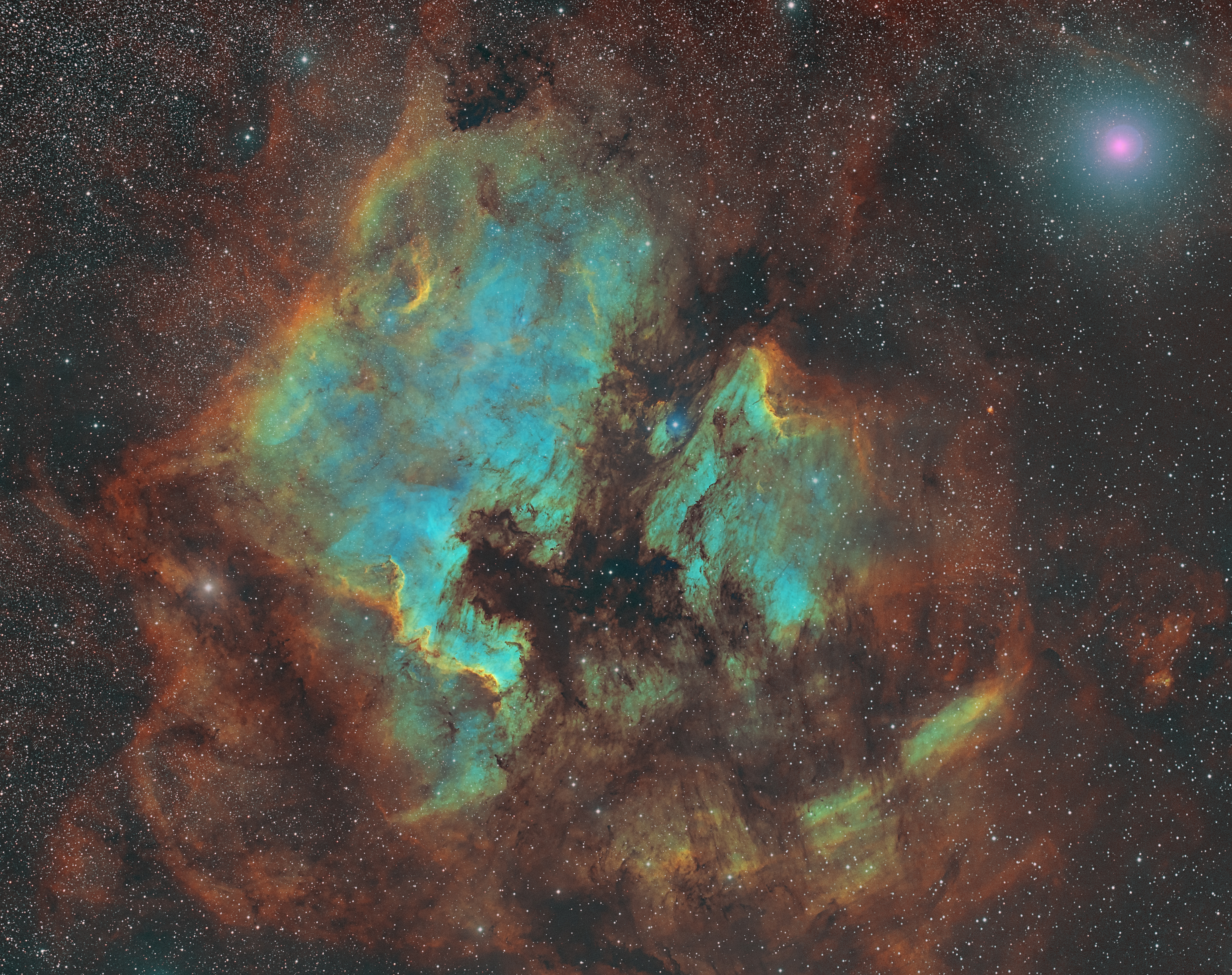NGC 7000, IC 5070 - Nordamerika- und PelikannebelNGC 7000, IC 5070 - North American and Pelican Nebula
 Fahre mit der Maus über das Bild um es zu vergrössern
Move the mouse over the image to enlarge it
Fahre mit der Maus über das Bild um es zu vergrössern
Move the mouse over the image to enlarge it
 Klicke das Bild für eine grössere Ansicht an
Click the image for a larger view
Klicke das Bild für eine grössere Ansicht an
Click the image for a larger view
Details zum Nordamerikanebel
Nordamerikanebel (auch NGC 7000 genannt) ist die Bezeichnung eines diffusen Gasnebels im Sternbild Schwan am Nordsternhimmel.
Seinen Namen erhielt der Nebel aufgrund seiner Form, die an eine Landkarte des nordamerikanischen Kontinents erinnert. Am Himmel ist der Nebel mit 120 mal 100 Bogenminuten sehr ausgedehnt (der Vollmond hat einen Durchmesser von ca. 30'). Er ist relativ einfach zu finden, da er sich etwas östlich des hellen Sterns Deneb (α Cygni) im Schwan befindet.
Der Gasnebel ist zwischen 2.000 und 3.000 Lichtjahre entfernt (seine genaue Entfernung ist nur schwer zu bestimmen) und besteht überwiegend aus Wasserstoff, der teilweise in ionisierter Form (HII) auftritt und sichtbares Licht in Form von tiefroter Strahlung emittiert. Auf lang belichteten Fotografien erscheint der Nebel daher intensiv rötlich.
Die visuelle Beobachtung des Nebels ist allerdings trotz seiner Gesamthelligkeit von 6 mag ziemlich schwierig. Man benötigt einen völlig dunklen, mondlosen Himmel, der durch keine künstliche Lichtquellen gestört wird. Der Nebel kann dann mit einem Prismenfernglas als diffuses Objekt wahrgenommen werden.
Der Nordamerikanebel wurde im Jahre 1786 von William Herschel entdeckt. Im Jahre 1891 beobachtete Max Wolf an seiner privaten Sternwarte in Heidelberg den Nebel mit seinem 6"-Doppelastrografen. Die Beobachtung war eine der ersten mit Hilfe der Astrofotografie.
Details zum Pelikannebel
Der Pelikannebel (auch bekannt als IC 5070 und IC 5067) ist eine H II-Region, die mit dem Nordamerikanebel im Sternbild Cygnus assoziiert ist. Die gasförmigen Verformungen dieses Emissionsnebels ähneln einem Pelikan, was ihm seinen Namen gab. Der Pelikannebel befindet sich in der Nähe des Sterns Deneb und ist von seinem auffälligeren Nachbarn, dem Nordamerikanebel, durch eine mit dunklem Staub gefüllte Molekülwolke im Vordergrund getrennt. Beide sind Teil der größeren H II-Region von Westerhout 40.Der Pelikan wird viel untersucht, weil er eine besonders aktive Mischung aus Sternentstehung und sich entwickelnden Gaswolken aufweist. Das Licht junger energiereicher Sterne verwandelt kaltes Gas langsam in heißes und bewirkt, dass sich eine Ionisationsfront allmählich nach außen bewegt. Besonders dichte Filamente aus kaltem Gas sind noch zu sehen, und unter ihnen befinden sich zwei Jets, die vom Herbig-Haro-Objekt 555 ausgehen. In Millionen von Jahren wird dieser Nebel vielleicht nicht mehr als Pelikan bekannt sein, denn das Gleichgewicht und die Anordnung der Sterne und des Gases werden ein völlig anderes Erscheinungsbild hinterlassen.
Quelle der Beschreibung: Wikipedia**Details about the North American Nebula*
North American Nebula (also called NGC 7000) is the name of a diffuse gas nebula in the constellation Swan in the northern starry sky.
The nebula got its name because of its shape, which reminds of a map of the North American continent. In the sky, the nebula is very extended, measuring 120 by 100 arcminutes (the full moon has a diameter of about 30'). It is relatively easy to find, as it is located slightly east of the bright star Deneb (α Cygni) in Swan.
The gas nebula is between 2,000 and 3,000 light-years away (its exact distance is difficult to determine) and consists mostly of hydrogen, some of which appears in ionized form (HII) and emits visible light in the form of deep red radiation. On long-exposure photographs, therefore, the nebula appears intensely reddish.
However, visual observation of the nebula is quite difficult despite its overall brightness of 6 mag. One needs a completely dark, moonless sky, which is not disturbed by any artificial light sources. The nebula can then be seen as a diffuse object with prism binoculars.
The North American Nebula was discovered by William Herschel in 1786. In 1891 Max Wolf observed the nebula with his 6" double astrograph at his private observatory in Heidelberg. The observation was one of the first with the help of astrophotography.
Details about the Pelican Nebula
The Pelican Nebula (also known as IC 5070 and IC 5067 is an H II region associated with the North America Nebula in the constellation Cygnus. The gaseous contortions of this emission nebula bear a resemblance to a pelican, giving rise to its name. The Pelican Nebula is located nearby first magnitude star Deneb, and is divided from its more prominent neighbour, the North America Nebula, by a foreground molecular cloud filled with dark dust. Both are part of the larger H II region of Westerhout 40.
The Pelican is much studied because it has a particularly active mix of star formation and evolving gas clouds. The light from young energetic stars is slowly transforming cold gas to hot and causing an ionization front gradually to advance outward. Particularly dense filaments of cold gas are seen to still remain, and among these are found two jets emitted from the Herbig–Haro object 555. Millions of years from now this nebula might no longer be known as the Pelican, as the balance and placement of stars and gas will leave something that appears completely different.
Source of description: WikipediaAufnahmedetails Acquisition details
Frames:
Aufnahmedauer insgesamt: Total integration time: 35h 50m
Verwendete Ausrüstung Equipment used